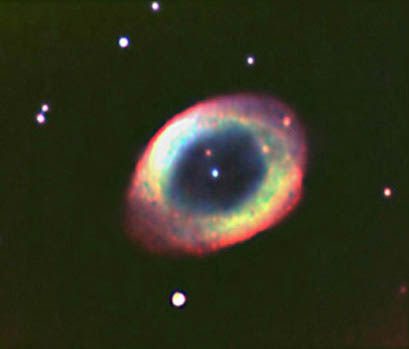
Osservazioni amatoriali di nane bianche
Amateur white dwarfs observations
by Fulvio Mete
Il Sistema di Sirio A e B: una ripresa difficile
Sirius A & B system: A difficult photo
Breve storia delle nane bianche
Man mano che le stelle simili al nostro sole invecchiano, vanno incontro a drammatici cambiamenti:Una volta bruciato tutto l'idrogeno diventano una cd. "gigante rossa" sviluppando una parte centrale sempre densa e più calda,che brucerà elio e si espanderà come un pallone che si gonfia, una bolla di gas in espansione ricca di idrogeno che inghiottirà buona parte del sistema solare.La bolla di gas espansa può dar luogo a quelle strutture che si chiamano "nebulose planetarie"(in Fig. 1a è mostrata la n.p. della Lyra,ripresa da chi scrive nel 2000).Una volta dissolta tale bolla di gas , resta solo un nocciolo estremamente denso e caldo, che costituisce quella che viene chiamata "nana bianca".Nella nostra galassia esistono probabilmente miliardi di nane bianche, ma queste sono così deboli da essere veramente difficili da osservare:Infatti nessuna nana bianca può essere vista a occhio nudo, e la maggior parte costituiscono oggetti difficili anche per i telescopi. La più vicina a noi è Sirio B, la compagna di Sirio, la più luminosa stella del cielo invernale, che dista poco meno di 9 anni luce da noi .Le nane bianche costituiscono l'inevitabile evoluzione di stelle di una certa classe,sino a 8 volte la massa del sole , che hanno esaurito il combustibile nucleare, l'idrogeno, e che una volta bruciati gli elementi più pesanti come l'elio,ed espulsi come si è detto gli strati più esterni sotto forma di un inviluppo di gas,saranno confinate in un nocciolo ultradenso ed estremamente caldo, grande circa come la terra, che attraverso miliardi di anni andrà raffreddandosi e diventando sempre meno brillante.Lo studio delle nane bianche è quindi lo studio del futuro lontano della nostra stella, che raggiungerà questo stadio tra 5 o 6 miliardi di anni,
A Short White Dwarfs Tale
As our Sun (and
similar stars) ages, it'll
undergo dramatic changes. It'll get hotter and brighter in the core, then puff
up like a balloon.Eventually, it'll shed its outer layers, surrounding itself
with a colorful but ephemeral bubble of gas. As the gas dissipates,only the
Sun's collapsed core will remain , an extremely dense and hot object.This dead
remnant is called a white dwarf. Billions of white dwarfs probably inhabit the
Milky Way, our galaxy. But they're so faint that they're hard to see. In fact, not a
single white dwarf is visible to the unaided eye. The closest one is a
companion to Sirius,one of the brightest star in the night sky, which shines in
the winter nights, less than nine light-years away from us.
A white dwarf is the inevitable fate of a certain class of stars , stars that
are no more than about 8 times as massive as the Sun .Over
this limit no collapsing star will be stable and it will generate a supernova
and its remnant will be a neutron star or a black hole. As the main sequence stars
as our sun age, they "burn
up" the hydrogen fuel in their cores. They then burn heavier elements as
helium, until
they can'tgenerate the temperatures needed to keep going and will shed its outer
layers forming a so-called planetary nebulas (In fig 1a is shown an image the
Lyra p.n taken by author on 2000)., ,Their collapsed cores, form ultradense, hot balls about as big as
Earth.Over many billions of years, they'll cool and fade. Evolution to a
white dwarf is a long-term project, though the Sun won't reach that final stage
of life for another five or six billion years.

.
Fig 1a
Nel grafico che segue è riportato
l'elenco delle nane bianche più vicine al nostro pianeta
In the following graph are shown the main and
brightest White Dwarfs closest to the earth.
|
|||||||||||||||||||||||||||||||||||||||||||||||||||||||||||||||||||||||||||||||||||||||||||||||||||||||||
| Source: ftp://nic.funet.fi/pub/astro/dbases/stars/potporri.txt |
Lo studio delle nane bianche e della loro evoluzione si interseca quindi con quello delle nebulose planetarie e può costituire un appassionante motivo di indagine e di contributo per l'amatore, per la relativamente esigua strumentazione richiesta , dato che è sufficiente un buon strumento a lunga focale, (Schmidt Cassegrain o Matksukov Cassegrain) una buona barlow 2X o 3 X, una stabile montatura e tanta perseveranza, tutti ingredienti a disposizione dell'astrofilo evoluto. Questa è la storia della mia esperienza, che continua tuttora.
The study of white dwarfs and their evolution can be a very interesting topic for the amateur astronomer , taking in the account the retatively modest setup required :a good long FL telescope( Schmidt Cassegrain or Matsukov Cassegrain ) a good 2x or 3 x barlow lens and a stable equatorial mount.This is the story of my experience, that still continues.
Nel Dicembre 2004, mi venne l'idea di tentare la ripresa CCD del sistema di Sirio, Sirio A e B, un'impresa quanto mai difficile per un astrofilo, data la enorme differenza di luminosità esistente tra le due componenti (circa 10 magnitudini).Sirio A (Alpha Canis Maioris) , è infatti una stella blu di classe spettrale A0 a temperatura superficiale di ca. 10.000 ° e magnitudine fotografica -1,6, distante circa 8,6 anni luce : Sirio B è una nana bianca , la prima ad essere scoperta, nel 1844 da Friedrich Bessel, con l'analisi delle perturbazioni indotte sul moto di Sirio ed osservata , nel 1862, da Alvan Clark con un telescopio da 18 pollici che stava testando per il Dearborne Observatory: la sua temperatura superficiale è di ca. 25.000° e la sua densità elevatissima, con una massa pari all'incirca a quella del sole concentrata in una sfera del diametro di 12000 Km , quindi il 90% quello della terra.La sua forza di gravità è ben 400.000 volte quella della terra!La sua elevata temperatura fa sì che emetta una forte radiazione nel dominio dei raggi X e dell'UV.
On december 2004, I wanted first to try the CCD imaging of Sirius A& B System, a very difficult task for an amateur to do, for the enormous brightness difference existing between the two components (About 10 Mag.).Sirius A (Alpha Canis Maioris) is a blue star of spectral class A0 with a surface temp of 10,000 C and photo mag of - 1.6, distant 8,6 light years from our sun.Sirius B is a white dwarf, the first to be discovered in 1844 by Friedrich Bessel and observed, in 1862, by Alvan Clark, through a 18 " telescope he was testing for Dearborne Observatory:its surface temp is about 25,000 C and its density very high, with a mass similar to that of the sun concentrated in a sphere of about 12000 Km, less than the one of earth.Its gravity force is consequently 400,000 times higher than on the earth!The high surface temp produce a massive radiation in X ray and UV domain.
Come dicevo, la differenza di
ca 10.000 volte tra i componenti ha fatto sì che l'osservazione di questi sia
stato appannaggio quasi esclusivo di strumenti professionali, come si vede dalle
riprese effettuate dal riflettore da 3 metri del Lick Observatory (Fig. 1) da
quella, più recente,del novembre 1999 dell'osservatorio satellitare a
raggi X Chandra (Fig 2, notare che Sirio B in questa immagine è la componente
più luminosa per la sua maggiore emissione, rispetto a Sirio A, nel dominio dei
Raggi X) e, infine, da quella dell'Hubble Space Telescope
dell' ottobre 2003 (Fig.8).
As I said, the brightness difference of 10,000 times between the components of Sirius system made the imaging exclusive domain of professional observatories, such as Lick, Mc Donald, in U.S.A.(Fig 1), outer space observatories such Chandra X Ray satellite in november 1999 (Fig.2, Note that Sirius B is the brighter component for its superior emission in X rays domain) and HST in october 2003 (Fig. 8).

Fig.1

Fig 2
Prendendo spunto dai suggerimenti di un vecchio articolo di Sky & Telescope, nel 1975, il solo caso di osservazione di Sirio B da parte di una amatore con un C14, stabilii di usare una maschera esagonale da anteporre al mio Schmidt Cassegrain da 28 cm Celestron 11 in modo da usare la lunga focale dello strumento usufruendo nel contempo di raggi di diffrazione artificiali nell'immagine stellare, nel cui punto di valle la compagna di Sirio fosse più visibile.La semplice maschera di cartone da inserire davanti alla lastra dello strumento è visibile nella fig.3.L'accorgimento, per quanto valido (una stella , nell'esempio Rigel, appare come nella Fig. 4) non si dimostrò sufficiente a mostrare Sirio B, anche per la focale (2800 mm) usata, che era insufficiente per abbattere la luminosità, e per il seeing non favorevole, dovuto ai camini dei riscaldamenti dei palazzi di fronte al balcone dal quale osservo.Quest'anno ho voluto ripetere il tentativo, ma in un modo diverso: ho aggiunto infatti alla maschera esagonale posta davanti alla lastra correttrice dello strumento un filtro di costruzione russa che equipaggiava un microscopio per l'esame in fluorescenza dei campioni.Detto filtro ha una banda passante di circa 30/40 nm ed è centrato sui 340 nm, esattamente al limite oltre il quale la radiazione dell'UV vicino non riesce più ad attraversare il vetro, ed occorrono lenti al quarzo per registrarla.Ciò perchè la caldissima nana bianca emette nel dominio dei raggi X e dell'UV, nel quale invece Sirio A è molto debole: tale filtro permette quindi di ridurre fortemente il divario di luminosità tra le due stelle. Esso è stato posto su una barra portafiltri inserita immediatamente prima della camera CCD, una Starlight MX 716 da 0.6 arcsec x pixel alla focale di 2800 mm del C11,ed il setup è stato quello indicato in fig 8b (flip mirror, oculare con reticolo per il centraggio dell'oggetto,slitta portafiltri con 2 filtri ai lati e la parte centrale vuota per una prima messa a fuoco di massima, camera CCD). La procedura usata è stata la seguente: è stato puntato Sirio senza filtro inserito, in quanto lo stesso è talmente scuro da non permettere una corretta messa a fuoco, affinata la messa a fuoco ed inserito il filtro, che è talmente sottile da richiedere uno spostamento trascurabile del fuoco, dopodichè sono iniziate le riprese, avendo cura ogni 3/4 scatti di ruotare la maschera di cartone dal punto di riferimento iniziale, sino a farle fare un giro completo,Il risultato migliore si è avuto con la maschera, il cui segno rosso era stato posto in corrispondenza della parte centrale superiore del tubo del C11 (dove in genere c'è il logo "Starbright coating"), posta col segno stesso a 90° a sinistra guardando la parte frontale del telescopio , ovvero,sempre guardando frontalmente la lastra del C11, con due angoli perpendicolari al logo sull'esterno del portasecondario(Fig 8c).L'esposizione è oscillata tra gli 0.3 ed 1 sec , ma i risultati migliori si sono avuti con l'immagine n.5 da 0.3 sec.Stavolta, l'ho notato subito, c'era qualcosa, ma ho proseguito le riprese sino al numero di 17, ed in tutte era visibile, in basso a sx un puntino sfocato, evidente molto di più nei punti di valle dei raggi di diffrazione.La migliore delle 17 immagini è mostrata in Fig.6 , mentre in Fig 5 la stessa immagine è stata sovraesposta per mostrare i raggi di diffrazione, appena visibili per la poca luce in arrivo nel telescopio.
Remembering an old photo of Sirius system made by an amateur astronomer (the only other I know) by a C14 Schmidt Cassegrain telescope in 1975, I made a cardboard exagonal mask (Fig 3) to apply to the front end of my Celestron 11, in order to use the focal lenght and the resolution of the instrument having, in the same time, some artificial diffraction rays in whose valley point the airy disk of Sirius A was narrower, to see Sirius B easier.The image must appear as in that of fig. 4, where is shown a photo of star Rigel, in Orion, with the mask.Anyway, at that focal lenght, in a try made last year, the device wasn't enough to show Sirius B, so this year I wanted to try it again, but in a different way, using the mask and a 340 nm microscope fluorescence filter with a passband of 30/40 nm, with the aim to strongly reduce the brightness difference between the two stars, taking in account that the UVA emission of Sirius A is quite low, and that of Sirius B is very high (I couldn't imagine how much).The visible light passing through this filter is very dim, and , watching a bulb, you can see the tungsten filament only .The setup used was the following: a commercial flip mirror, a sliding filter holder, and the Starlight Xpress Mx 716 CCD camera, that , at the focal lenght of 2800 mm, gave a resolution of 0.6 arcsec x pixel the setup used was the one shown in Fig 8b: flip mirror system, not illuminated reticle ocular, filter holder with two filters on the sides(340 and 380 nm) and the central hole free for a quick first focusing.I first aimed at Sirius without filter, for the 340 nm filter let pass so a small amount of light that focusing could be very difficult even with bright stars,then focused the scope, and, after having the filter inserted,definitely focused the image and began shooting, with 3/4 images every mask 90° rotation.The exposure was between 0.3 and 1 sec, but best results were at 0.3 secs, with the red mark on the mask placed on the left side of the tube (watching it from the front), at 90° from the mark "Starbright coating" on the tube, or, that's the same, with two mask angles set perpendicular at the logo on the external part of secondary holder (Fig 8c).At my first attempt, december 23, 2005, I took 17 images, the best of all shown in Fig 6, while in fig 5 the same image is overexposed to show the diffraction spikes of the mask.

Fig. 3
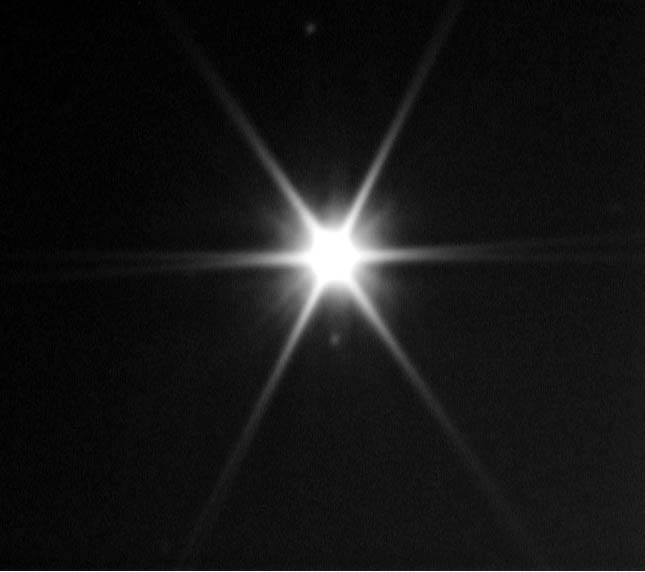
Fig. 4
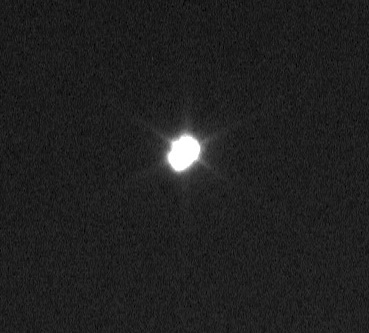

Fig 5 Sirius AB system 23.12.2005 21.00 UT Fig 6 Sirius AB system 23.12.2005 21.00 UT 340nm
In realtà la luce che passa attraverso il filtro è veramente poca: si pensi che traguardando attraverso questo la luce di una lampadina si vede il solo filamento e nulla altro.Risulta anche molto difficile osservare Sirio in visuale, così sono dovuto ricorrere ad un espediente per centrare la stella: una slitta portafiltri ed un flip mirror prima della camera, in modo da puntare la stella senza filtro, e poi inserire il filtro al momento della ripresa.Questo spiega l'attenuazione della luce ripresa dalla camera CCD MX 716 , che peraltro ha anche un'ottima risposta nel blu, come vedremo.Dopo la ripresa è venuto il momento dei riscontri: mi sono dovuto infatti accertare che la posizione della presunta nana bianca fosse proprio quella di Sirio B nella sua orbita cinquantennale intorno alla stella principale. Mi è stato utilissimo, a tal fine, un lavoro del Dipartimento di fisica del MIT che riporta tale orbita dal 1950 al 1999 : ho quindi estrapolato orientativamente la posizione di Sirio B nel 2005 ed ho inoltre aggiunto al grafico in modo approssimativo (dato che l'orbita di Sirio B è 2,4 volte più grande di quella di Sirio A) l'orbita della stella principale intorno al comune centro di massa.La direzione assiale, (orientamento non perfetto della camera verso il nord) sembrava in un primo momento coincidere, mentre la posizione di Sirio B sull'orbita, pur tenendo conto del moto proprio di Sirio, poteva considerarsi reale a patto di effettuare una rotazione dell'immagine di 180°.
After imaging, I began to make the necessary controls, to be sure of observation results, that clearly showed a double star, one of them could be Sirius B.The first thing was to achieve the Orbit of Sirius B, I obtained from a work by MIT in the web for years from 1950 to 1999, I modified to 2005, inserting that I think to be the orbit of Sirius A along the common center of mass, taking in account that Sirius B orbit is 2,4 times wider than that of Sirius A.Obviously, this isn't a precise work, but enough to have an idea of the angle between the two stars, according to the professional images too.

Fig. 7
Le operazioni di controllo effettuate sono state le seguenti:
1) Individuazione dell'orientamento esatto dell'immagine, che sembra facile, in linea di principio, ma che tale non è in quanto dipendente , oltre che dalla posizione fisica della camera rispetto al telescopio, da software di gestione della CCD.
2) Controllo di eventuali riflessi interni del sistema flip mirror - slitta portafiltri - camera CCD
3) Esclusione di cause dovute a riflessi od artefatti del software della camera, con la rotazione della camera intorno al proprio asse.
4) Misurazione della distanza tra i centri delle due stelle contigue, tenendo conto del valore di un singolo pixel in secondi d'arco, che nel C11 a 2800 mm di focale con il chip della Starlight MX 716 corrisponde a 0.6 secondi d'arco per pixel.
5) Misurazione della posizione, tenendo anche conto del moto di Sirio A, oltre che quello di Sirio B, intorno al comune centro di massa.
In detail, the control operations were the following:
1)Definition of exact image orientation, that could appear a simple job, but isn't, depending on the camera position in relation to the scope and the mount, and the camera software.
2)Internal reflection control, essentially that of flip mirror- filter holder- CCD camera setup.
3)Exclusion of reflections or software artifacts by rotation of the camera around its own axis.If the object rotate in the same amount of the camera, in a direction or other (due to the camera orientation and software) it must be real.
4)Measure of distance in pixel between the centers the two stars, considering the arcsec/pixel coverage: this could be obtained with some softwares, as the freeware "CCD" and some others.In my case, the C 11 at f 10 and the MX716 CCD , the pixels were about 10, with a total distance, at 0.6 arcs/pixel, of 6 arcsecs, that was the right distance.
5)Measure of relative position angle considering the motion around the common center of mass.
Per quanto riguarda il punto 1), la camera è stata orientata con la sua base (la piastrina col foro filettato fotografico) posta parallela all'asse di declinazione, a sinistra osservando la parte posteriore del telescopio, come indicato in fig. 8 e 8b.E' stata quindi puntata Sirio, portata al centro del quadro immagine , iniziata la ripresa , fermato il moto orario, e poi terminata l'esposizione: la direzione nella quale si produce la "strisciata", ovvero quella in cui si muove la stella, è l'ovest, quella opposta è l'est (Fig 9)Nel caso in esame il nord si trova in basso, mentre nel caso opposto (movimento verso la destra dello schermo e l'ovest alla dx) si troverebbe in alto.L'immagine è quindi invertita dalla posizione e dal software di gestione della camera, che nel caso è stato il noto Star MX 7 della Starlight Xpress.
In relation to point 1) the CCD camera was oriented with its base (the photographic threaded hole plate) set parallel to declination axis, on the left hand watching the backside of the scope, as shown in Fig. 8 and 8b. The scope was then aimed to Sirius, I begun the exposition and ,after,stopped the RA motion of the mount.The direction indicated by the light stripe of star motion is always the west. In my case, the west was on the left side of image, and , then the east at the right, north down and south up (Fig.9) in relation to the software being used, Star MX7, by Starlight Xpress.


Fig 8 Fig 8b


Fig 9 Fig 8c
Per il punto 2) ho provveduto a rivestire di vellutino nero tutte le superfici del flip mirror e degli anelli di raccordo, traguardando poi il tutto in direzione di una forte sorgente di luce sino a riscontrare l'assenza di qualsiasi forma di riflesso.
Referring to point 2) i covered of black velours paper alla internal surfaces of flip mirror, adapter rings, and so on, observing , when done, toward a strong light source to check the total absence of reflections.
Per il punto 3) ho effettuato due successive riprese, ruotando la camera di 45° circa in direzione antioraria, riscontrando che l'oggetto ruotava dello stesso angolo e si trovava alla fine in posizione corrispondente all' angolo di rotazione effettuato sebbene nel senso opposto, dato l'orientamento invertito dell'immagine.(Fig 10).
For point n.3), I took two shots, rotating the camera counterclockwise, and found that object rotated of the same angle, notobstanding the opposite direction due to the inversion of image.(Fig 10)


Fig 10 Fig.11
Per il punto 4) , la misurazione della distanza tra le due stelle dell'immagine è stata effettuata con un comune software di fotoritocco, ed è stata individuata in 10 pixel circa, corrispondente a 6 secondi d'arco (alla copertura di 0.6 arcsec x pixel del C11 a 2800 mm F), quindi la distanza tra le due stelle quasi esatta in base alle orbite reciproche intorno al comune centro di massa.
For point n. 4) the measurement of distance in pixel of the two stars in the image has been done by a common photo processing software, and found of about 10 pixel, corresponding to 6 arcsec.
Relativamente alla misurazione della posizione, questa si è dimostrata più difficile del previsto, ed il motivo è presto detto:osservando l'immagine in Fig.6, con il nord in basso, sembrava scontato che Sirio A fosse la stella più luminosa in alto, e Sirio B quella in basso: tuttavia, confrontando tale immagine con quella della posizione reciproca dei due corpi nell'orbita attorno al comune centro di massa, sembra che la stessa sia invertita, e che quindi, per far coincidere Sirio B con la posizione nel grafico, l'immagine stessa avrebbe dovuto subire una rotazione di 180 °, cosa non spiegabile in alcun modo.Ho allora verificato numerose volte l'orientamento dell'immagine scaricata dalla camera, trovandola corretta, ma niente; Sirio B continuava ostinatamente a trovarsi, secondo me, in una posizione opposta a quella in cui avrebbe dovuto trovarsi!Cominciando a temere un possibile riflesso e quindi un immagine non reale, provai a ruotare la camera tra due riprese, e l'oggetto si spostava mantenendo la posizione reciproca, segno che era reale.Il rompicapo durò per un giorno abbondante, sino a che mi venne l'idea, osservando l'immagine di Chandra, dove in primis avevo scambiato Sirio A per B, data la minore emissione del primo nel dominio dei raggi X.Stabilii allora di fare una prova; confrontare una ripresa col solito filtro da 340 nm (Fig 12) con un'altra con un filtro simile centrato invece sui 380 nm (Fig13) con lo stesso setup, e, ovviamente, con la camera nella stessa posizione: ed il miracolo accadde:la stella più piccola che nell'immagine col filtro a banda più vicina all'UV sembrava Sirio B era invece Sirio A, mentre l'immagine a 380 nm mostrava la realtà, con la posizione reale dei due oggetti:Allora tutto quadrava e la ripresa CCD multibanda dell'ostica nana bianca era finalmente stata effettuata.L'immagine della Fig. 12 col filtro a 340 nm è data dalla compositazione di 5 immagini singole (le migliori) :la relativa maggior estensione delle immagini stellari rispetto a quella della Fig 13 (filtro da 380 nm) è dovuta non tanto ad una peggiore messa a fuoco, quanto all'alone della radiazione UV attorno agli oggetti luminosi.
Referring to the point 5) the relative position of Sirius A & B, this was much more difficult than I could thought, for the following reason: observing the image in Fig. 6 (the first I took on december 23), with north in its low end, it may seem obvious that Sirius A is the brighter object, in the upper part of image, and Sirius B the dimmer star below it.Anyway, comparing the image with the System orbit diagram shown in Fig 7 it doesn't match, and to to this, it ought to be rotated of 180°.Such a rotation had no rational explanation, so a some doubts began to bear in my mind.I checked again every source of possible reflections, but nothing, it seemed everything be OK , checked once again the image orientation, but nothing: it looked like the image must be 180° rotated to match.At last, I remember that, looking to the Chandra Xray observatory image, I had first thought Sirius A be the brighter object, while it was the contrary, so I had the idea to repeat the observation, using another type of filter: similar to that of 340 nm CWL i used on december 23 2005, but of 380 nm CWL; well, the images, hereunder shown,speak by themselves:the UV emission of the hottest Sirius B are going to grow toward the shortest wavelenght so at 340 nm the UV signature of the star is more intense than that of Sirius A : going toward the longest wavelenghts and the visible part of the spectrum, the trend is inverted, and Sirius A appears more bright.Note that the greater star images in the 340 nm photo aren't due , in my opinion, at a telescope focusing problem, but to the UV halo surrounding the bright stars.Both images are the stacking of a few shots (5 for the 340 nm image, and 6 for the other).
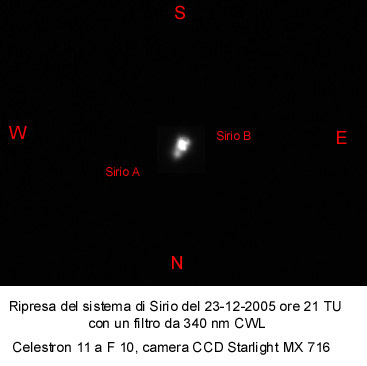
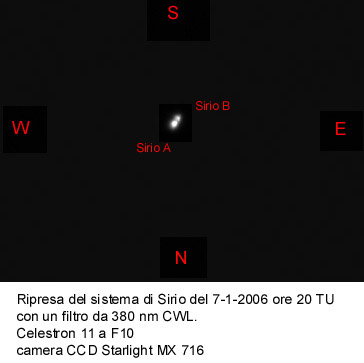
Fig.12 Fig 13
Una prova di tale situazione è data dall'esame del flusso UV dello spettro tra 1000 e 3500 A di Sirio B (fonte ESA) riportato nella immagine sottostante, nel quale si nota un picco di intensità proprio in corrispondenza dei 3350 A.
An evidence of such an observation is given by the Sirius B UV flux between 1000 and 3500 A reported in the following ESA image, that shows an UV intensity peak just at 3350 A.
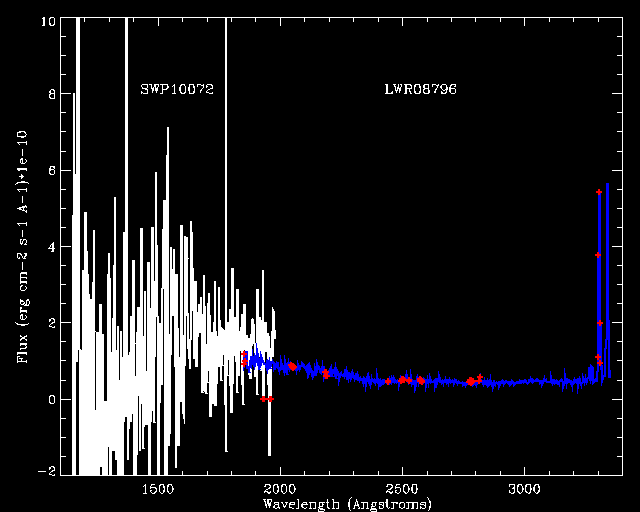
Una ulteriore conferma della posizione è data dall'immagine dello Hubble Space Telescope dell'ottobre 2003 del sistema di Sirio A e B.Opportunamente ruotata per ottenere lo stesso orientamento, nella predetta immagine, l'angolo dell'asse tra le due stelle coincide quasi completamente con quello della mia , come si può osservare nella elaborazione in Fig. 14: una piccola differenza angolare è dovuta al non perfetto parallelismo della camera con l'asse di declinazione della montatura.
A further confirm of the correct mutual position of the two stars is given from the following image, in which the central part of image of Fig 13 has been superimposed as negative layer on last HST image of Sirius System (set with the same orientation).A little angular difference is due to the not perfect alignment between the camera and the mount declination axis
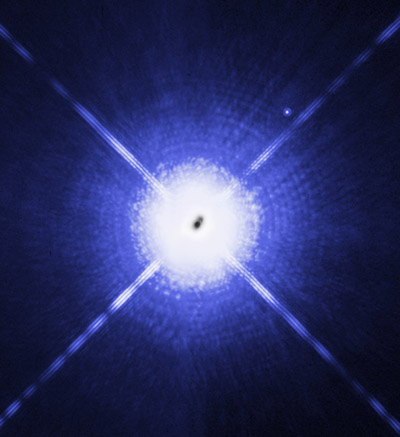
Fig. 14
E' opportuno parlare ora dei filtri, dei comuni filtri per microscopia in fluorescenza, centrati su 340 e 380 nm, probabilmente filtri di eccitazione.Essi hanno svolto in modo egregio il loro compito, selezionando l'UV vicino nella luce in arrivo e consentendo la ripresa, altrimenti non possibile per l'eccesso di radiazione blu di Sirio. Tali filtri non sono lavorati a tolleranze ottiche superiori, ma hanno il pregio di essere fortemente selettivi avendo il compito di filtrare accuratamente la luce in arrivo sul campione da una lampada UV facendo in modo che la radiazione sia esclusivamente quella desiderata.Nella figura 14 sono mostrati i filtri in questione nel porta filtri lineare. Notare la notevole differenza tra il filtro da 380 nm (a destra) e quello da 340 nm (a sinistra) nell'assorbimento della luce.Quest'ultimo appare quasi nero-violaceo e lascia passare una modestissima quantità di luce visibile, mentre l'altro lascia intravedere un'immagine (fig 15).
It is useful, now, to talk about the filters used : common fluorescence microscopy excitation (I think) filters, with 340 and 380 nm CWL ; I don't know exactly the passband , but it could be about 30/40 nm the,Such a filters haven't, in my opinion, a very good optical quality, but are very useful for the job, for they must let pass, from an UV lamp, exclusively the UV radiation to the object being examined in fluorescence.They are then very selective.These filter mounted on the filter holder are shown in Fig 14. Note the density of the 340 nm filter (on the left) compared to that of 380 nm one (on the right): the first appears almost black - violet and , looking through it the visible image is extremely dim , whilst the second appears deep blue and let some visible light pass trough it (Fig 15).
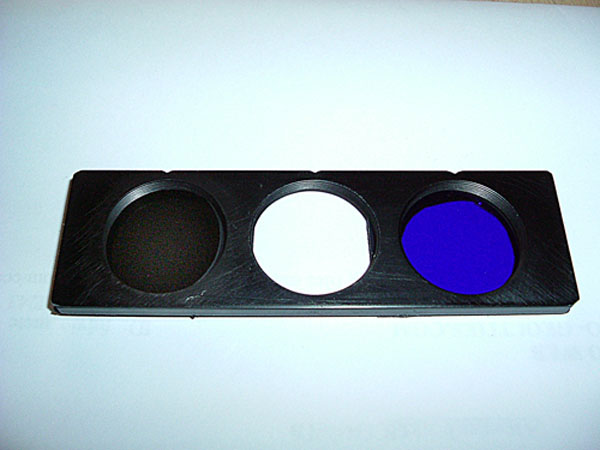
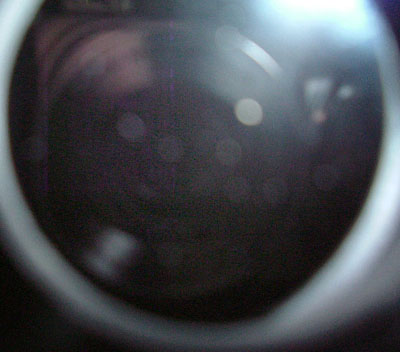
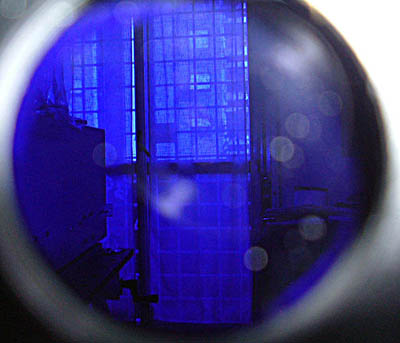
Fig 15
Un discorso a parte merita la camera utilizzata, una Starlight X Press MX 716 USB con sensore Sony ICX249AL Ex view, dalla notevole risposta spettrale nell'UV vicino (34% circa a 400 nm, circa 32,5% a 380).La sensibilità nell'UV di tale camera è stata infatti per me un'assoluta novità, ed una piacevole sorpresa, ed ha reso possibile le riprese descritte in questa pagina.Ritengo utile riportare, di seguito, il grafico dell’efficienza quantica del sensore Sony della MX 716 paragonato a quello dei sensori Kodak KAF 401 (Fig. 16).Occorre anche tener conto, a tale proposito, di un possibile “appiattimento” della curva tra i 350 ed i 300 nm (con una probabile QE di 28% a 340), segnalato, oltre che dalla mia, anche dalle esperienze di altri amatori.Sembra, quindi che tale camera sia particolarmente idonea per le riprese CCD nella banda spettrale UVA.
Another point of interest is the noticeable UV spectral response of the CCD camera being used, a Starlight X press MX716 USB, with a Sony ICX249 AL EX view chip, whose spectral response is 34% at 400 nm and 32,5% 20% at 380 nm .This was a pleasant new that made possible to obtain the images shown above.I think it is useful to show, hereunder, a QE graph of Sony chip,compared to those of Kodak KAF 401 series.It must be considered, on the point, of a possible flattening of the curve between 350 and 300 nm(with a possible 28% QE at 340 nm.

Il Sistema di Procione A e B: vicino al limite
Procyon A & B system: near to the limit
I risultati positivi ottenuti con le riprese del sistema di Sirio A e B mi hanno convinto a tentare un'impresa ancora più difficile, al limite dell'impossibile con strumenti amatoriali: Procione splendeva in queste serate invernali a poca distanza da Sirio, e costituiva una possibilità troppo invitante per lasciarsela sfuggire:Il metodo era stato collaudato con successo: perchè quindi non tentare? La brillante stella della costellazione del Cane minore costituisce, come Sirio, un sistema doppio formato da una stella di sequenza principale, classe F5, mag.vis. 0.38 ed una nana bianca, Procione B, classe DA e mag. 10.64, con una massa di 0.65 volte quella del sole:essa è poco più grande della terra (ca il 30%) e la sua densità è superiore persino a quella di Sirio B: le due stelle distano 11,41 anni luce dalla terra e sono separate da circa 14,9 UA (circa 16 volte la distanza terra-sole) con un'orbita ellittica attorno al comune centro di massa che Procione B completa in ca. 40,8 anni.La differenza di luminosità di 15.000 volte e la distanza angolare da terra (attualmente ca. 3 secondi d'arco) rende le due stelle difficilmente distinguibili ai telescopi amatoriali, tantè che non sono riuscito a trovare, sul web, notizia di riprese analoghe da parte di amatori.Procione B fu scoperta visualmente nel 1896 da John Schaeberle col rifrattore da 36 " del Lick Observatory.
The positive results obtained with Sirius System imaging, made me ready to try another ,more difficult, attempt: the Procyon A -B imaging, near the limit of amateur chances.Procyon shined, in that winter evening, not far from Sirius: it was a true temptation: why not?The method was tested and succeed: it was the case to give a try.The bright star of Canis Minor constellation , Procyon , like Sirius, has a companion star , Procyon B.Procyon belong to F5 spectral class,vis. mag. 0.38, while Procyon B is a white dwarf, class DA , vis mag. 10,64, with a 0.65solar mass in a diameter a little bigger than earth, its density is higher than Sirius B and its orbit around the common mass center takes 40.8 years.The brightness difference of 15,000 between the two components and the reduced angle of sight from earth (about 3 arcsecs) make the two stars' splitting a very difficult task for amateur telescopes, near the limit: I didn't find, till now, any evidence of other amateur imaging of the system.Procyon B was visually discovered in 1896 from John Schaeberle by the 36" refractor at Lick Observatory.
La prima serata di seeing accettabile, il 7 gennaio 2006, preparai quindi il telescopio per tentare l'impresa, al fuoco diretto del C11, anche se ero consapevole che la focale di 2800 mm e la risoluzione di 0.6 arcsec/pixel sarebbe stata probabilmente insufficiente per mostrare Procione B.Feci tre serie di riprese: una senza filtri, una col filtro da 340 nm ed una col filtro da 380 nm: il risultato, mostrato qui di seguito , parla da solo (Fig 1, 2 e 3): come pensavo, la focale era sufficiente a mostrare l'elongazione di Procione, ma insufficiente per una separazione più completa dei due componenti.L'immagine a 340 nm mostra inoltre , intorno a Procione B un alone probabilmente dovuto dovuto all'emissione UV , e la relativa immagine stellare è dilatata a similitudine di quanto accaduto per Sirio B.Le immagini ottenute sono la media di 16 immagini singole per le riprese a 340 nm, di 8 immagini per le riprese a 380 nm e 3 immagini per quelle senza filtro.
The first good seeing evening, on january, 7 2006, I set the scope to try the Procyon B imaging, at the prime focus of C11, notobstanding I was aware that the focal lenght of 2800 mm and a 0.6 arcs/pixel resolution couldn't be enough to split the double star.I took three series of images (Fig 1, 2 and 3) one without filter, one with the 340nm filter, and the last with 380 nm filter.The result speak by itself: the relative short focal lenght used showed only the elongation of Procyon A due to the presence of Procyon B, but wasn't able to split the two components.The 340 nm image showed, furthermore, a light halo, probably due to the UV emission of Procyon B, with a larger star image, as happened with Sirius B.The images obtained are the median of 16 single shot at 340 nm , 8 at 380, and 3 without filters.
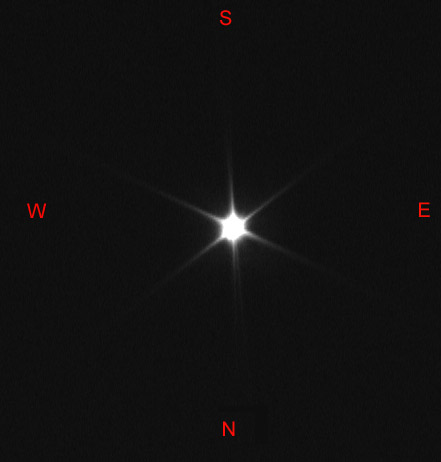
Fig 1: Procyon image on 7.1.2006 with no filter


Fig 2 Procyon image on 7.1.2006 with 340 nm filter Fig 3 Procyon image on 7.1.2006 with 380 nm filter
Alcune sere dopo, il 12 gennaio 2006, posi la camera MX 716 al fuoco del C11 ad F20, utilizzando una Barlow Ultima 2X, per una FEQ di 5600 mm ed una risoluzione di 0.3 arcsec /pixel.Stavolta la risoluzione doppia mi permise di sdoppiare abbastanza nettamente le due componenti a 380 nm, (Fig.4).Il setup e l'orientamento della camera era stato identico a quello della ripresa di Sirio B.
A few evenings later, on january, 12 , 2006 I put the camera MX 716 at the C11 F20 focus, using a 2X Ultima Barlow lens, with a EFL of 5600 mm and a resolution of 0,3 arcsec/pixel and the 380 nm filter.Now, the doubled resolution let the scope to split the two components of the system: The 340 nm images were not good, due to the larger star images and to the seeing not excellent.
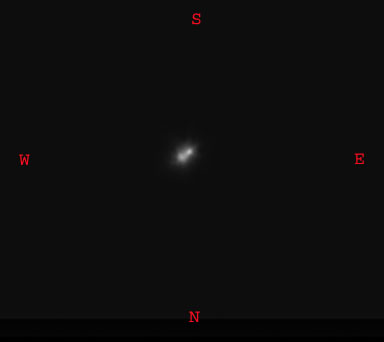
Fig 4 - Procyon A B system imaged on 12.1.2006 by 380 nm filter
L'orientamento della camera era sempre lo stesso, mentre per la definizione dell'angolo di posizione reciproco dei componenti nell'orbita mi sono avvalso del diagramma indicato al seguente link di Richard Dibon Smith: http://www.dibonsmith.com/cmi_con.htm
The camera orientation was always the same, while, to define the position angle between the two stars in their orbit, I used the diagram , found in the web at the following link of Richard Dibon Smith: http://www.dibonsmith.com/cmi_con.htm

Osservando l'immagine della Fig 4, ottenuta nella zona spettrale ai confini tra UV e visibile, viene spontaneo di chiedersi quale sia il contributo di Procione B (Classe DA, nella quale risultano evidenti le righe della serie di Balmer) allo spettro a media risoluzione di Procione mostrato in Fig 5 ed ottenuto da chi scrive con CLAUS, nella riga dell'Hdelta a 4102 A, che appare di una intensità relativa maggiore delle righe più spostate verso il verde (Hgamma, H beta) ; purtropppo però indagini di tale livello superano la possibilità di un astrofilo, e forse anche di alcuni osservatori professionali.
Watching the image in Fig.4, obtained in the spectral region at the border between UV and visible, It could be spontaneous for us to wonder in what measure the Procyon B (DA class, in which the hydrogen Balmer serie lines are evident) spectrum may contribute to the overall emission of Procyon spectrum shown in Fig 5, (I imaged it by CLAUS medium resolution spectroscope) considering that H delta absorbing line at 4102 A seems to be quite stronger than the others Hydrogen lines toward the green band.

Fig 5